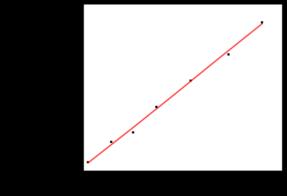
NavList:
A Community Devoted to the Preservation and Practice of Celestial Navigation and Other Methods of Traditional Wayfinding
Re: Lunars: Jupiter's BIG.
From: Fred Hebard
Date: 2003 Dec 20, 15:03 -0500
From: Fred Hebard
Date: 2003 Dec 20, 15:03 -0500
Frank, I reduced your data and plotted your lunar times against the time of observation, below. The data look very nice; not as good as the lunar of that Australian explorer Kieran Kelly discussed a few months ago, but very good. The line is a least squares fit of a straight line. Interestingly, I usually plot the raw distance against the time of observation and use the least squares fit to pick out a point for reduction. In this case, I chose your first observation, which was out by 48 seconds. I should have chosen the third or fourth observation, which, being in the middle, were closer to the fit of the line to the average of the observations. I think perhaps the old method of using the mean of the observations would be better than using a line of best fit, although plotting the data instantly tells one how good they are. Using the mean, the time would have been out by 8 seconds, about 2 minutes of longitude. Fred Obs# time of observation time from lunar diff 1 12/19/03 9:30:37 12/19/03 9:31:24 48 2 12/19/03 9:33:31 12/19/03 9:34:28 58 3 12/19/03 9:36:15 12/19/03 9:35:50 -24 4 12/19/03 9:39:15 12/19/03 9:39:37 23 5 12/19/03 9:43:30 12/19/03 9:43:35 6 6 12/19/03 9:48:15 12/19/03 9:47:30 -45 7 12/19/03 9:52:30 12/19/03 9:52:22 -7 On Dec 20, 2003, at 3:53 AM, Frank Reed wrote: > When you shoot lunars with Jupiter, you soon discover that the giant > planet has a visible semidiameter through a good sextant. The accepted > practice is to split the planet -- you take it to the Moon's limb and > place the disk of the planet as best you can with its center right on > the limb so that the planet is split in half along the Moon's limb. > That's do-able... > > Fortunately, Jupiter is far enough away that parallax is no issue > (it's always less than 0.04 minutes of arc for Jupiter). > > If anyone's interested, here's a set of Jupiter-Moon lunars from last > night taken with a reliable Plath sextant: > > Index Correction: +0.7 > Assumed Position: Lat = 41d 22N, Lon = 71d 57W > Temp: 30F. Pressure: Normal. > > All Lunars are Jupiter-Moon-Far Limb. Times are EST (US Eastern > Standard Time). Sights start at Greenwich Date 12/19/2003, 09:30: > > 04:30:37,? 43d 49.5 > 04:33:31,? 43d 51.1 > 04:36:15,? 43d 51.7 > 04:39:15,? 43d 53.7 > 04:43:30,? 43d 55.7 > 04:48:15,? 43d 57.6 > 04:52:30,? 44d 00.1 > > Enjoy! > > Frank E. Reed > [X] Mystic, Connecticut > [ ] Chicago, Illinois







